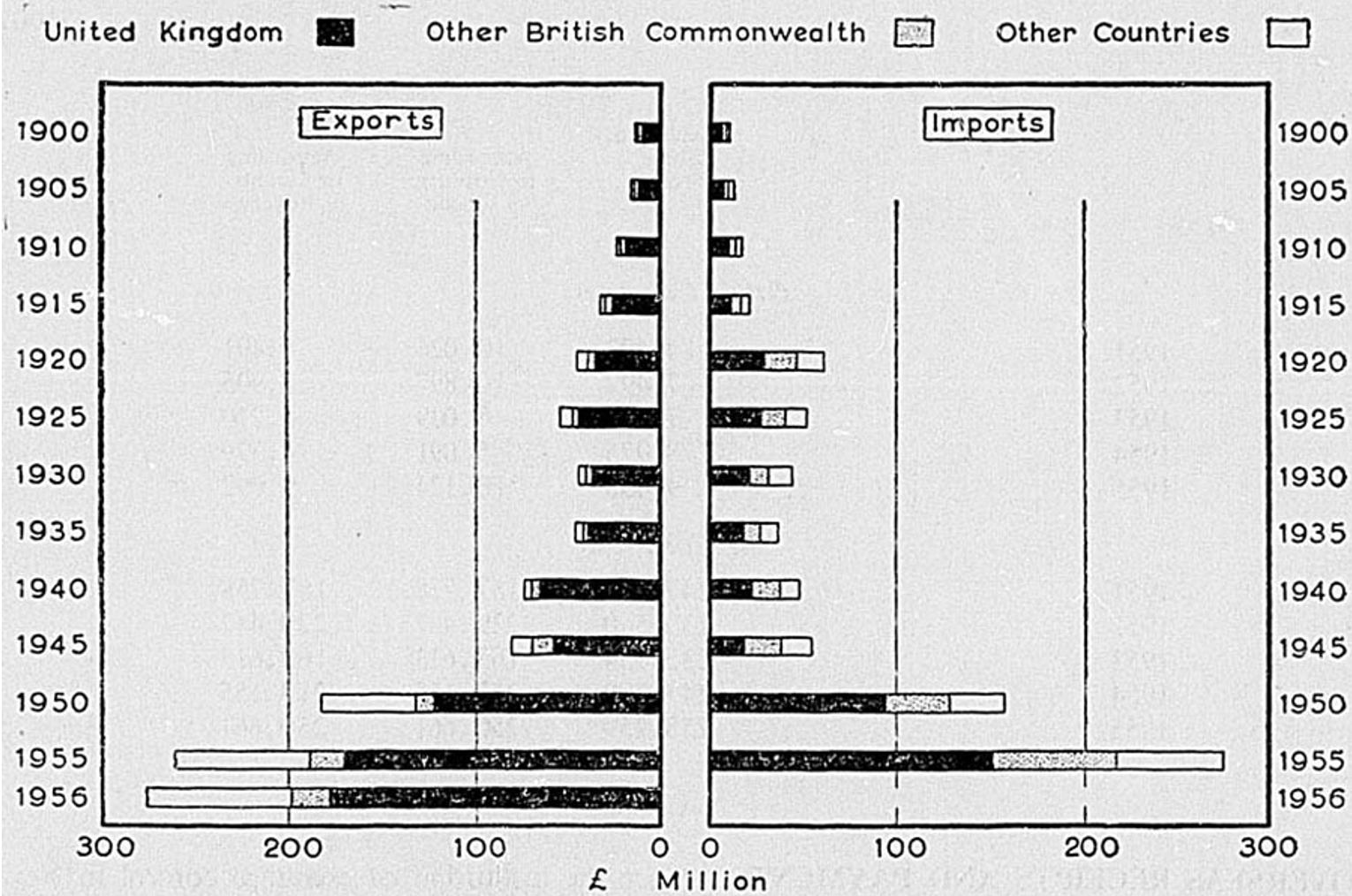65 years of exporting Aotearoa
Reflecting on what Aotearoa New Zealand has produced over the last 65 years, and where we have sent these goods, reveals the changing face of the country on the world stage.
This 65th birthday article looks at the export story of Aotearoa New Zealand.
The United Kingdom was our strongest trading partner in 1957
As the world was recovering from the devastation of the Second World War, there was a resurgence in trade from 1946 to 1957, and New Zealand began trading with the United States. Trade with the UK dominated exports, equalling £169 million (out of £256 million) worth of goods. The following figure from the Statistics New Zealand 1957 Yearbook shows that New Zealand was very much a Commonwealth country, but our relationship with countries outside of the Commonwealth was strengthening.

Source: Statistics New Zealand
New Zealand had a minimal trade relationship with China in 1957. £152,000 worth of goods were exported to China, and £107,000 worth of goods were exported to Hong Kong.
Products produced from the land made up 96.6 percent of exports in 1955, including dairy produce, meat, wool, and hides, skins, and pelts. Of these products, wool had the highest share of export value (36 percent), followed by dairy (27 percent), and meat (26 percent). In 1955, New Zealand supplied 70 percent of frozen mutton and lamb imported into the UK.
New Zealand was also importing more timber than it was exporting; 50.5 million board feet of sawn timber was imported in 1955, while 42.7 million board feet of sawn timber was exported. At this time the amount of indigenous timber exported, such as kauri and tawa, was reduced as radiata pine forests were harvested and generated better returns.
The UK joined the EU and our exports dwindled
A lot can happen in 65 years when looking at global relationships, and New Zealand’s history with trade is no different. In 1973 the United Kingdom joined the European Economic Community (EEC), which would become the European Union (EU). As a result, New Zealand had to explore new markets for its exports. In 1983 New Zealand signed its first Free Trade Agreement (FTA) with Australia, so that goods produced in New Zealand could enter Australia free of tariffs or import taxes. In 1995 the World Trade Organisation (WTO), of which New Zealand was a founding member, was established. This organisation led to the establishment of further FTAs for New Zealand:
- with Singapore in 2001
- with Thailand in 2005
- with China in 2008
- with Malaysia in 2009 (entered into force in 2016)
- the Closer Economic Partnership (CEP) with Hong Kong in 2011
- with South Korea in 2015
- the Comprehensive and Progressive Agreement for Trans-Pacific Partnership (CPTPP) signed with 11 countries in the Asia pacific region in 2018
- with the UK (ratified this year)
- to be established with the EU this decade.
Dairy still an important export product
New Zealand exported $63.3 billion worth of goods in 2021 with dairy exports earning the largest share of revenue, in part thanks to historically high prices for dairy products. The export revenue collected by dairy was close to $18 billion for 2021. Meat and edible offal came in second, followed by forestry (wood and timber products).
A key difference in today’s economy is the importance of services in exports. Before COVID-19, services accounted for 30 percent of exports, valued at $22.7 billion in 2017, while goods were valued at $53.6 billion. However, because of COVID-19 border controls, most services exports have seen a marked decrease. The Ministry for Foreign Affairs and Trade (MFAT) expects the services sector to see an increase in revenue for the 2022 year due to the return of travel, although it is likely to be a slow recovery.
MFAT released the Trade Recovery Strategy 2.0 this year, which outlines how the country will approach trade in the uncertain times ahead. The pillars of the strategy are:
- Sustainable and inclusive trade; supporting the Trade for All Agenda to deliver the benefits of trade to all New Zealanders.
- Trade and export lift; trade diplomacy to lift the capability for New Zealand exporters to reach more markets.
- Architecture; seeking strong FTAs so that businesses can trade under predictable rules.
- Resilience: promoting diversification of trade, mitigating supply chain pressures, and reducing emissions.
Our trading partners have dramatically changed since the 1950s. We are now less of a Commonwealth trader but more of a Pacific trader. We still draw the most overseas revenue from exporting from our land; in the 1950s this was from sheep, and now this is from cows. Our trade priorities indicate that this may change as we diversify, so in the future there may be no clear industry to lead exports. It will be up to New Zealand businesses to determine what these diversified exports will be. As always, international markets and politics are rarely stable, so in the next 65 years who with, what, and how we trade may look even more different than it does looking back from 2022 to 1957.